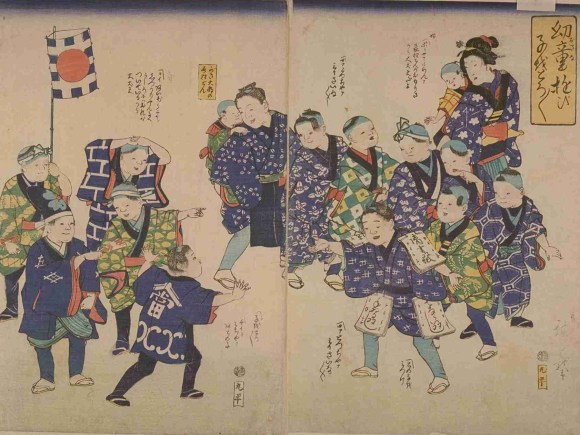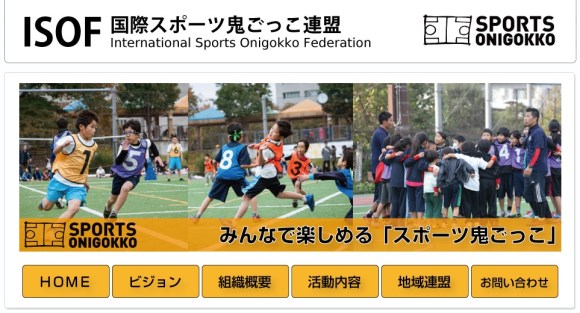
No matter what culture you come from, you have probably played a game of tag or a similar game by a different name at least once in your life. It’s a childhood pastime that quite possibly dates well back into prehistoric times in one form or another.
In Japan it is well-loved and goes by the name onigokko (“play demon”) wherein on player takes the role of the oni (demon/”it”) and tries to touch the other players which will turn them into oni.
I say “well-loved” because in recent years the country has held the largest games of tag in the world and has currently evolved the game into “sports onigokko” an organized team-based version of the of what you may know as tag.
■ For your health!
The modern game of onigoko has been traced back to a game played in the Heian period. Going into the Edo period it took on the name kotorokotoro (“catch kids, catch kids”) and featured three roles: oni, parent, and child. Like onigokko the target is to catch the other players, but in kotorokotoro one of the other players is the parent behind whom all other players (the “children”) must stay behind in single file. Every child the oni touches then becomes and oni and the game ends when all of the children are taken.

While onigokko has evolved into a more individual player’s game since then the International Sports Onigokko Federation (ISOF) has brought a bit of that team spirit back in sports onigokko. It was originally started in the ’80s by Josai University Professor Yasuo Hasaki as a way to combat childhood obesity. The sport is highly competitive so requires a degree of physical activity and exercise, but the method of play requires no special equipment or training.
■ Rules
Sports onigokko is played on a 15m by 25m court with a stand on either end (see the image at the top of this page). The stands have a small cylinder on top which the players must snatch from the opposing team’s side. However, once a player enters that side they can be tagged and forced to return to their own side off-court.
There are also safety zones in the four corners of the court which offensive players can be protected from getting tagged. Tags must be two-handed and of course excessive hitting or other violent contact will not be tolerated. Every time the cylinder is grabbed a point is scored and the team which gets the most points in two five-minute halves is the winner.
■ You’re it Tokyo 2020!
The sport is constantly being reviewed for rule changes and additions to make it more entertaining under the auspices of the ISOF and Inetnational Onigokko Association (IOA). The ISOF is currently headed by Yasuo Hasaki’s son Takao Hasaki who has been hard at work promoting the sport.
Recently it has undergone what some call a “silent boom” where its popularity has increased substantially but without any major media attention. The games inherent inclusiveness and requirements for strategic teamwork and communication has made it a favorite for corporate and community building events. Some have even worked it into a group dating exercise giving you the chance to triumph over some special guy or gal with you tag skills.
All in all, it’s been reported that around 180,000 people have played sports onigokko to date. A national tournament has been established and currently there are plans to expand to an international one by 2016 incorporating some Southeast Asian countries who have taken an interest in it. The next milestone for Hasaki and the rest of the association is clear: a spot as a demonstration sport at the 2020 Tokyo Olympic Games.
Although people’s gut reaction might be to scoff at sports onigokko as a glorified kids game, but really it appears to be sports at its purest. The game has a high emphasis on physical ability and strategy and also leaves very little room for luck in the equation.
Perhaps the Olympic committee will see it that way too and give sports onigokko a shot. We may also have a good chance seeing it at the games if they decide to choose the demonstration sport by rock-paper-scissors or eeny, meeny, miny, moe.
Source: International Onigokko Association, International Sports Onigokko Federation, Yahoo! Japan News, Hachima Kiko (Japanese)
Top Image: IOA
Video: YouTube – International Onigoko Association


 Pikachu and Super Mario left out of lineup of official spokescharacters for Tokyo Olympics
Pikachu and Super Mario left out of lineup of official spokescharacters for Tokyo Olympics Chiba police looking for man threatening to kill kids who don’t play tag with him
Chiba police looking for man threatening to kill kids who don’t play tag with him Japan’s Harajuku Station to be rebuilt ahead of 2020 Tokyo Olympics
Japan’s Harajuku Station to be rebuilt ahead of 2020 Tokyo Olympics Naomi Osaka chooses Japanese citizenship over U.S., hopes to represent Japan at Tokyo Olympics
Naomi Osaka chooses Japanese citizenship over U.S., hopes to represent Japan at Tokyo Olympics Japan Airlines giving foreign travelers 100,000 free round-trip tickets during the Tokyo Olympics
Japan Airlines giving foreign travelers 100,000 free round-trip tickets during the Tokyo Olympics Starbucks at Shibuya Scramble Crossing reopens, but is it really bigger and better than before?
Starbucks at Shibuya Scramble Crossing reopens, but is it really bigger and better than before? Two things to do, and two things not to do, when leaving a traditional Japanese inn
Two things to do, and two things not to do, when leaving a traditional Japanese inn One of Japan’s oldest castles now lets travelers spend night on the grounds, drink in its keep
One of Japan’s oldest castles now lets travelers spend night on the grounds, drink in its keep Orange Juice Crisis ’24 – Japan’s OJ supplies drying up
Orange Juice Crisis ’24 – Japan’s OJ supplies drying up Foreign traveler caught trying to sneak into Japan by climbing down rope from cruise ship
Foreign traveler caught trying to sneak into Japan by climbing down rope from cruise ship Bad tourist manners at Mt Fuji Lawson photo spot prompts Japanese town to block view with screens
Bad tourist manners at Mt Fuji Lawson photo spot prompts Japanese town to block view with screens Studio Ghibli unveils massive T-shirt collection featuring top anime movie characters
Studio Ghibli unveils massive T-shirt collection featuring top anime movie characters McDonald’s Japan’s new pancake pie is a taste sensation
McDonald’s Japan’s new pancake pie is a taste sensation Studio Ghibli unveils new goods that tip the hat to The Cat Returns
Studio Ghibli unveils new goods that tip the hat to The Cat Returns Yakuza lieutenant arrested in Tokyo for stealing Pokémon cards
Yakuza lieutenant arrested in Tokyo for stealing Pokémon cards Foreigner’s request for help in Tokyo makes us sad for the state of society
Foreigner’s request for help in Tokyo makes us sad for the state of society Red light district sushi restaurant in Tokyo shows us just how wrong we were about it
Red light district sushi restaurant in Tokyo shows us just how wrong we were about it Japanese city loses residents’ personal data, which was on paper being transported on a windy day
Japanese city loses residents’ personal data, which was on paper being transported on a windy day McDonald’s new Happy Meals offer up cute and practical Sanrio lifestyle goods
McDonald’s new Happy Meals offer up cute and practical Sanrio lifestyle goods Japanese ramen restaurants under pressure from new yen banknotes
Japanese ramen restaurants under pressure from new yen banknotes Ghibli Park now selling “Grilled Frogs” from food cart in Valley of Witches
Ghibli Park now selling “Grilled Frogs” from food cart in Valley of Witches New definition of “Japanese whiskey” goes into effect to prevent fakes from fooling overseas buyers
New definition of “Japanese whiskey” goes into effect to prevent fakes from fooling overseas buyers Our Japanese reporter visits Costco in the U.S., finds super American and very Japanese things
Our Japanese reporter visits Costco in the U.S., finds super American and very Japanese things All-you-can-drink Starbucks and amazing views part of Tokyo’s new 170 meter-high sky lounge
All-you-can-drink Starbucks and amazing views part of Tokyo’s new 170 meter-high sky lounge More foreign tourists than ever before in history visited Japan last month
More foreign tourists than ever before in history visited Japan last month New Pokémon cakes let you eat your way through Pikachu and all the Eevee evolutions
New Pokémon cakes let you eat your way through Pikachu and all the Eevee evolutions Disney princesses get official manga makeovers for Manga Princess Cafe opening in Tokyo
Disney princesses get official manga makeovers for Manga Princess Cafe opening in Tokyo French Fries Bread in Tokyo’s Shibuya becomes a hit on social media
French Fries Bread in Tokyo’s Shibuya becomes a hit on social media Sales of Japan’s most convenient train ticket/shopping payment cards suspended indefinitely
Sales of Japan’s most convenient train ticket/shopping payment cards suspended indefinitely Sold-out Studio Ghibli desktop humidifiers are back so Totoro can help you through the dry season
Sold-out Studio Ghibli desktop humidifiers are back so Totoro can help you through the dry season Japanese government to make first change to romanization spelling rules since the 1950s
Japanese government to make first change to romanization spelling rules since the 1950s Ghibli founders Toshio Suzuki and Hayao Miyazaki contribute to Japanese whisky Totoro label design
Ghibli founders Toshio Suzuki and Hayao Miyazaki contribute to Japanese whisky Totoro label design Doraemon found buried at sea as scene from 1993 anime becomes real life【Photos】
Doraemon found buried at sea as scene from 1993 anime becomes real life【Photos】 Tokyo’s most famous Starbucks is closed
Tokyo’s most famous Starbucks is closed One Piece characters’ nationalities revealed, but fans have mixed opinions
One Piece characters’ nationalities revealed, but fans have mixed opinions We asked a Uniqlo employee what four things we should buy and their suggestions didn’t disappoint
We asked a Uniqlo employee what four things we should buy and their suggestions didn’t disappoint “Caterpillar Rugby” aims to level the playing field for people with and without disabilities
“Caterpillar Rugby” aims to level the playing field for people with and without disabilities Japanese artists anthropomorphise national flags into samurai characters for 2020 Tokyo Olympics
Japanese artists anthropomorphise national flags into samurai characters for 2020 Tokyo Olympics 500-Step Soccer: A new sport from Mizuno and World Yuru Sports Association
500-Step Soccer: A new sport from Mizuno and World Yuru Sports Association Japan has a new professional basketball league exclusively for anime voice actresses
Japan has a new professional basketball league exclusively for anime voice actresses Emperors, anime icons, and porn stars show up in six-nation survey of most famous Japanese people
Emperors, anime icons, and porn stars show up in six-nation survey of most famous Japanese people Tokyo University students rank the top 12 video games for cultivating smart kids
Tokyo University students rank the top 12 video games for cultivating smart kids 5 Japanese women who can kick your ass (in martial arts)【Women in Japan Series】
5 Japanese women who can kick your ass (in martial arts)【Women in Japan Series】 The Paralympics’ first official video game becomes an entirely new breed of sports game
The Paralympics’ first official video game becomes an entirely new breed of sports game Tokyo train stations get new Olympic melodies and signage for the Games
Tokyo train stations get new Olympic melodies and signage for the Games Talented Japanese sixth graders pull off mind-blowing jump-rope routine【Video】
Talented Japanese sixth graders pull off mind-blowing jump-rope routine【Video】 Google made a free-to-play ninja cat RPG to celebrate the Tokyo Olympics, and it’s awesome!
Google made a free-to-play ninja cat RPG to celebrate the Tokyo Olympics, and it’s awesome! Human pyramids continue in Kobe schools as injuries mount to 51, mayor’s pleas to stop unanswered
Human pyramids continue in Kobe schools as injuries mount to 51, mayor’s pleas to stop unanswered This table tennis player shows that “nothing is impossible” 【Video】
This table tennis player shows that “nothing is impossible” 【Video】 Tokyo Olympics might allow you to take one, and only one, drink with you into sweltering stadiums
Tokyo Olympics might allow you to take one, and only one, drink with you into sweltering stadiums Piko Taro holds virtual Pikofest to help kick off Paralympics in its official video game
Piko Taro holds virtual Pikofest to help kick off Paralympics in its official video game Japan Snow Battle Federation looking to make snowball fights Olympic event
Japan Snow Battle Federation looking to make snowball fights Olympic event
Leave a Reply